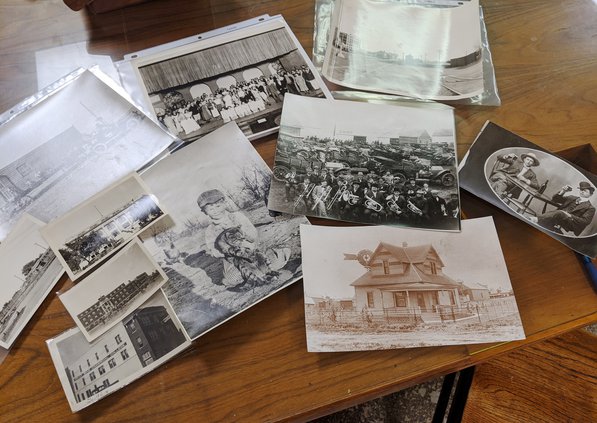Dale and Betty Riggs, owners of Riggs Studio, spent some of their downtime during the statewide pandemic shutdown doing some housecleaning and going through an accumulation of old photos from the 1920s, 1930s and 1940s. They contacted the Barton County Historical Society, and museum codirectors Karen Neuforth and Leslie Helsell came over to have a look. After confirming the photos’ historical value, they eagerly accepted donation Riggs Studio graciously offered on behalf of the museum.
“Riggs Studio is part of a continuation of a series of photo studios in Great Bend, going from John Piper, who was originally over on Forest Ave., and then Bill Brannon who was located on Main Street and was active in the 1970s and 1980s,” Neuforth said.


The persons in the photo, for the most part, are unidentified, but there are identifiable landmarks. Historians looking at the clothing styles and makes and models of automobiles can get a ballpark estimate of the time period.
A few of the photos feature the entire casts of the Great Bend High School Music Department operettas from the 1930s. One, “Look Who’s Here,” was directed by Helen Opie, then about 22 years old, and included characters played by Margaret Slentz, Russell Townsley, Helen Edman, Rush Barles, Robert Lee, Ed Moses, Virginia Powell, Frances Younkin, Bob Templeton, Irwin Tucker, Jack Caraway, Walter Weiss, Willmer Bledsoe, Chester Flory, Gilbert Russell, Tom Taylor and Jack Schmidt, all of whom appear posed front and center on stage, with a huge accompanying cast surrounding them. A sign above them on the curtain reads “Class of 1935.” Many went on to be community boosters throughout their adult lives.
The photos span the county, and include a handful of photos taken in front of the Hoisington Municipal Complex, the Albert fire department, the courthouse square and downtown Great Bend, and other locations that so far are still a mystery.
“We’re working on designing a calendar which will include as much of Barton County as we can,” Helsell said. “We’ve got so many pictures in our collection that nobody gets to see. We thought if we could just go through and make calendars, we could have a new one each year. It would give everyone a chance to see so much of everything.”


Determining whether or not a vintage photo is worthy of preservation can be tricky,and often depends on circumstances, said Neuforth, who herself owns an extensive collection and hates to turn down photographs or throw them away.
If it’s one the museum already has six copies of, or if it simply features an unidentified person, it’s hard to justify adding it to the collection. Places of business, however, are more easily identified.
“One of the things that I love most is when we ended up with pictures of a building that is still standing, but has been changed radically from its original construction,” Neuforth said.
The building on the northwest corner of Forest Ave. and Main Street where the Chelsea photography studio is located today is an example. It started out as a wood frame building, and later, brick and native stone were applied. Metal siding was later added, and in recent years removed once more.
Once a photo is accepted into the collection, negatives are acquired and stored or a photograph of the photo is taken so a negative is on file. The photograph is cataloged and a copy of the photo is then made. It is labeled with the original’s catalog number, and these copies are then stored for visitors to look through and identify originals they’d like to see. This saves valuable vintage photographs from receiving excessive handling.
Thanks to the internet and the creation of companies that make researching genealogy less complicated than in years past, the hobby has grown in popularity over the last decade. In any given year, the museum receives visitors from all around the country and abroad researching their family history.
Occasionally a researcher asks for a copy for themselves, and the museum will have a reproduction made for the cost of processing.
The Barton County Historical Museum and Village is once again open to the public, Tuesday through Friday from 10 a.m. to 5 p.m.





